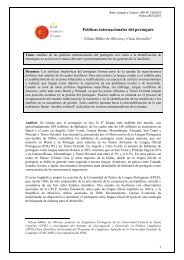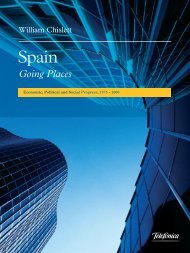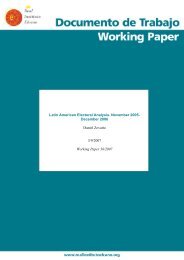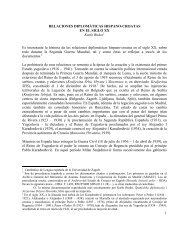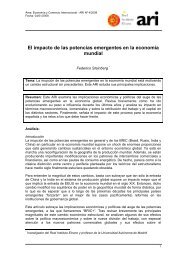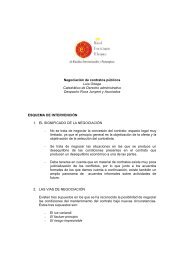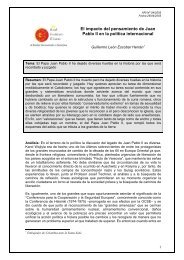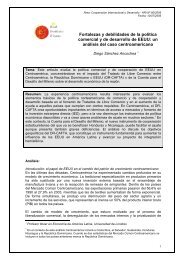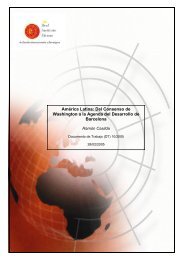Spain and the United States - Real Instituto Elcano
Spain and the United States - Real Instituto Elcano
Spain and the United States - Real Instituto Elcano
Create successful ePaper yourself
Turn your PDF publications into a flip-book with our unique Google optimized e-Paper software.
CHAPTER 1<br />
OVERVIEW<br />
Had it not been for <strong>Spain</strong>, <strong>the</strong> <strong>United</strong> <strong>States</strong>, as we know it today, might never<br />
have existed.<br />
Juan Ponce de León l<strong>and</strong>ed in 1513 on <strong>the</strong> east coast of what is today <strong>the</strong><br />
state of Florida <strong>and</strong> claimed it for <strong>the</strong> Spanish crown. In 1526 Lucas Vázquez<br />
de Ayllón explored <strong>the</strong> coast of Georgia <strong>and</strong> South Carolina, <strong>and</strong> in 1539<br />
Hern<strong>and</strong>o de Soto l<strong>and</strong>ed on <strong>the</strong> west coast of Florida with a large company,<br />
becoming <strong>the</strong> first white men to see <strong>the</strong> Mississippi River. Alvar Núñez Cabeza<br />
de Vaca sailed along <strong>the</strong> nor<strong>the</strong>rn coast of <strong>the</strong> Gulf of Mexico <strong>and</strong> went through<br />
what is today Texas. In 1565 Pedro Menéndez de Avilés founded St. Augustine<br />
in Florida, <strong>the</strong> oldest continuously inhabited city in <strong>the</strong> <strong>United</strong> <strong>States</strong>. 1 When<br />
<strong>the</strong> English ship, <strong>the</strong> Mayflower, arrived in Plymouth, Massachusetts, in 1620,<br />
<strong>the</strong> Spanish empire was already well established.<br />
At <strong>the</strong> time of <strong>the</strong> American Revolution (1775-83), almost all of <strong>the</strong><br />
modern-day <strong>United</strong> <strong>States</strong> west of <strong>the</strong> Mississippi River up to Canada, as well<br />
as what is now called Mexico (<strong>the</strong>n known as New <strong>Spain</strong>), was a territory of<br />
<strong>Spain</strong>. <strong>Spain</strong> was an ally of France <strong>and</strong> an economic competitor of Great<br />
Britain. It took <strong>the</strong> side of <strong>the</strong> American rebels, more out of hatred for Britain,<br />
its old rival, than for any enthusiasm for <strong>the</strong> cause of independence, which it<br />
feared would spread to <strong>the</strong> Spanish colonies in Latin America, as it eventually<br />
did. <strong>Spain</strong> hoped that a British defeat would enable it to recover those parts of<br />
Spanish America (Jamaica, Honduras, parts of west Florida) <strong>and</strong> Europe<br />
(Gibraltar <strong>and</strong> Menorca) that <strong>the</strong> British had occupied.<br />
1. The Americas are named after <strong>the</strong> Italian navigator Amerigo Vespucci, who sailed in 1499 – seven years<br />
after his friend <strong>and</strong> rival Christopher Columbus first l<strong>and</strong>ed in <strong>the</strong> West Indies. Vespucci’s breakthrough came on<br />
his second voyage, when he realised that what he was exploring was not India (as Columbus had thought) but a<br />
new continent. He verified this by following <strong>the</strong> coast of South America down to within 600km of Tierra del<br />
Fuego. “Since Europe <strong>and</strong> Asia have received <strong>the</strong> names of women, I see no reason why we should not call this<br />
o<strong>the</strong>r place Amerige or America, after <strong>the</strong> wise man that discovered it,” said <strong>the</strong> German cartographer Martin<br />
Waldseemüller in 1507.



